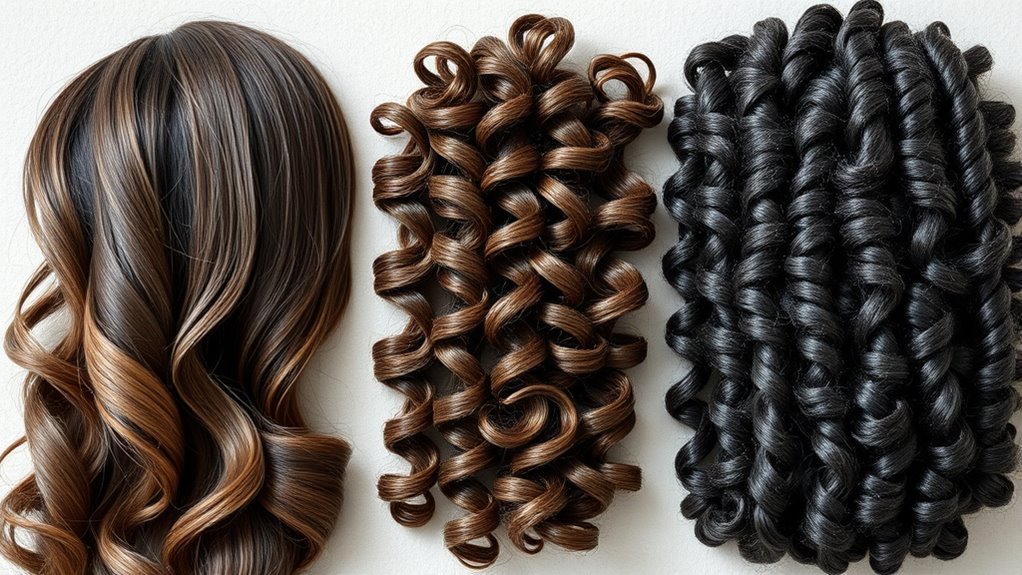Understanding curl types helps you customize your hair care routine for healthier, more defined curls. Wavy hair has loose S-shaped strands and benefits from lightweight, hydrating products. Curly hair features springy, spiral patterns that need moisture and curl-enhancing products. Coily hair has tight zig-zag curls requiring extra hydration and gentle handling. Knowing these differences allows you to choose the right techniques and products; continue to explore for tips to embrace your curl pattern fully.
Key Takeaways
- Wavy hair has loose, S-shaped patterns, sitting between straight and curly textures, and is prone to frizz without proper care.
- Curly hair features defined, springy S or spiral patterns that are often drier and require moisture-rich products.
- Coily hair consists of tight, zig-zag densely packed curls, making it highly fragile and necessitating gentle, hydrating treatments.
- Understanding curl patterns helps tailor hair care routines, including product choice and styling techniques like diffusing, scrunching, or protective styles.
- Proper identification of each curl type maximizes natural beauty by using suitable methods to reduce frizz, breakage, and maintain healthy curls.

Have you ever wondered why your curls look different from someone else’s? The truth is, curl patterns vary widely, and understanding your specific curl type can make a huge difference in how you care for and style your hair. Whether you have wavy, curly, or coily hair, adopting the right hair care routines and styling techniques tailored to your curl pattern will help you achieve the best results. Your hair’s unique texture is influenced by factors like the shape of your hair follicles and the distribution of your scalp’s natural oils, which is why no two curls are exactly alike.
Every curl is unique, shaped by follicle structure and oil distribution.
If you have wavy hair, your curls tend to form loose S-shaped patterns that sit somewhere between straight and curly. Wavy hair often feels soft and lightweight but can be prone to frizz if not cared for properly. To keep your waves looking defined and healthy, focus on gentle hair care routines that minimize damage. Use sulfate-free shampoos and moisturizing conditioners to preserve your hair’s natural oils. When it comes to styling techniques, consider applying a lightweight leave-in conditioner or a curl-enhancing mousse to define your waves without weighing them down. Diffusing your hair on a low heat setting can boost volume and help maintain your natural texture, especially on humid days. Avoid heavy products that can flatten your waves or cause buildup, and instead, embrace techniques like scrunching or plopping to enhance your natural pattern.
Moving into the domain of curls, which are more defined and springy, your hair forms tighter S or spiral shapes. Curly hair is often more prone to dryness because the natural oils have a harder time traveling down the twists and turns of each strand. Your hair care routine should prioritize moisture and gentle cleansing, so you want to look for rich conditioners and deep conditioning treatments. When styling, use curl creams or gels designed to enhance and hold your pattern. Techniques like finger-coiling or scrunching can help define individual curls and reduce frizz. To keep your curls looking bouncy and well-formed, consider using a diffuser attachment on your blow dryer, working on a low heat setting, to dry your hair without disrupting the curl pattern. Avoid brushing dry curls, as that can cause frizz and breakage—stick to wide-tooth combs or your fingers for detangling.
If you have coily hair, your curls are tight, densely packed, and often form a zig-zag pattern. Coily hair tends to be the most fragile and requires extra careful hair care routines. Hydration is key, so incorporating deep conditioning masks regularly is essential. Using sulfate-free, moisturizing shampoos and applying oils or creams can help lock in moisture and reduce breakage. When styling, your focus should be on gentle handling and defining curls with creams or butters that provide hold without causing buildup. Protective hairstyles, like twists or braids, help minimize manipulation and damage. To keep your coils looking their best, avoid excessive heat styling and opt for low-manipulation techniques like finger-coiling or setting your hair in rollers. Remember, maintaining moisture and minimizing friction are essential to keeping your coily curls healthy, shiny, and well-defined.
Understanding your specific curl type allows you to tailor your hair care routines and styling techniques effectively. Embrace what makes your curls unique, and with the right approach, you’ll reveal their full potential.
Frequently Asked Questions
How Can I Identify My Curl Type Accurately at Home?
To identify your curl pattern accurately at home, start by washing and air-drying your hair without touching it. Observe your natural curl pattern when your hair is dry, noting whether your curls are loose waves, tight spirals, or coils. For precise curl pattern identification, use at home testing by examining your hair’s texture from roots to ends, and compare it to common curl type descriptions. This helps you choose the right styling and care routine.
What Products Work Best for Each Curl Pattern?
You’re in the driver’s seat when it comes to choosing products for your curls. For wavy hair, lightweight gels and mousses work best for definition. Curly hair responds well to creams and leave-in conditioners that add moisture and hold. Coily locks thrive with rich, hydrating butters and oils to reduce frizz. Follow curl-specific routines and experiment to find what truly makes your curls pop—sometimes, you’ve got to kiss a lot of frogs!
How Do I Prevent Damage to My Curly Hair?
To prevent damage to your curly hair, focus on maintaining healthy hair porosity and scalp health. Use gentle, sulfate-free shampoos to avoid stripping natural oils, and deep condition regularly to keep moisture locked in. Avoid excessive heat styling, and always use heat protectant products. Regular scalp massages boost circulation, promoting healthier growth. By caring for your scalp and understanding your porosity, you can keep your curls strong, shiny, and damage-free.
Can My Curl Pattern Change Over Time?
Yes, your curl pattern can change over time due to factors like age, hormonal shifts, or hair treatments. You might notice hair texture changes and curl pattern evolution as your hair responds to these influences. To support healthy curls, avoid harsh chemicals and heat styling, and keep your hair well-moisturized. Embrace these changes, and remember that your hair’s natural pattern can adapt and evolve over the years.
What Styling Techniques Enhance My Natural Curl Pattern?
Did you know 65% of people with curly hair see improved curl definition with the right techniques? To enhance your natural curl pattern, focus on using a gentle curl definition method, like scrunching or finger-coiling. Consider your hair’s porosity—high porosity hair benefits from leave-in conditioners, while low porosity prefers lightweight products. Avoid heat and harsh styling, letting your curls bounce naturally for the best results.
Conclusion
Embrace your unique curl pattern as a beautiful part of your natural charm. Whether your waves gently dance, your curls spring with personality, or your coils radiate boldness, each one tells a story worth celebrating. With a little care and confidence, you’ll find your hair’s rhythm and style, making every day a chance to shine. So, cherish your curls—they’re your signature, your crown, and a reminder that beauty comes in many wonderful forms.









